Health
Allergic to wife
1966: After suffering from asthma for 15 years, Sigurd Lindh learned that he was allergic to his wife, Greta. He moved into a cabin 600 yards from their home, and his asthma cleared up.It's pretty rare for spouses to be allergic to each other (as in, actually having a physical reaction to the other's presence, not just hating each other's guts). But it's doubly rare for a husband to be allergic to a wife. So Lindh was pretty unique. For whatever reason, the overwhelming majority of these spousal allergy cases involve wives allergic to their husbands. See here and here.

Detroit Free Press - June 2, 1966

Akron Beacon Journal - Sep 12, 1966
Posted By: Alex - Tue Apr 18, 2017 -
Comments (1)
Category: Health, Marriage, 1960s
Mudlavia
Miracle mud cures!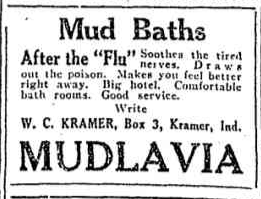
Wikipedia page.

Great article with primary source material here.
Posted By: Paul - Tue Apr 04, 2017 -
Comments (0)
Category: Architecture, Fads, Health, Regionalism, Natural Resources, Nineteenth Century
The Hand Drop Test

Steve notes that the test is remarkably reliable, and the reason this is so is because:
However, he warns that there are patients who have "played the game before" and may be able to fake a convincing response even to the hand drop test. In an article on "Faking Unconsciousness" in the journal Anaesthesia (April 2000), the author noted:
Posted By: Alex - Tue Mar 14, 2017 -
Comments (2)
Category: Health
Sneeze cured deafness
1973: Jean Haynes was almost deaf since birth, but then an allergic reaction triggered a bout of sneezing. Seems that she sneezed quite a bit. But finally, she gave one big sneeze, and suddenly she could hear again.This falls into the recurring weird news theme of accidental cures (such as people who get hit in the head and are cured of blindness).
But I'm also reminded of the cases of people who blew their nose and had an eye fell out.
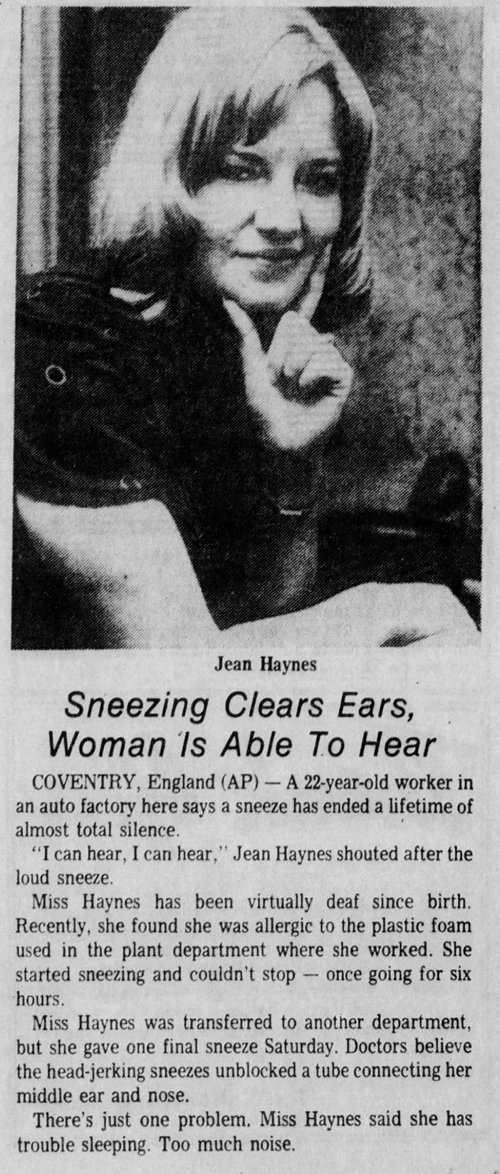
La Crosse Tribune - Jan 9, 1973
COVENTRY, England (AP) — A 22-year-old worker in an auto factory here says a sneeze has ended a lifetime of almost total silence.
"I can hear, I can hear," Jean Haynes shouted after the loud sneeze.
Miss Haynes has been virtually deaf since birth. Recently, she found she was allergic to the plastic foam used in the plant department where she worked. She started sneezing and couldn't stop — once going for six hours.
Miss Haynes was transferred to another department, but she gave one final sneeze Saturday. Doctors believe the head-jerking sneezes unblocked a tube connecting her middle ear and nose.
There's just one problem. Miss Haynes said she has trouble sleeping. Too much noise.
Posted By: Alex - Mon Feb 13, 2017 -
Comments (6)
Category: Health, 1970s
Allergic to her husband
BBC News reports on the case of Johanna Watkins who has a rare disorder (Mast Cell Activation Syndrome) that has caused her to become allergic to a whole bunch of stuff, including the scent of her husband. The allergy only developed after they got married.At this point, they live in the same house but can no longer get close to each other. Instead they communicate via phone. Their "date night" involves watching a show together: "he will be three floors below me in a room on his laptop and I will be on mine and we'll watch the show at the same time and then text about it as we're watching it."

Scott and Johanna Watkins
This reminds me of the 1949 case of Joyce Holdridge, aka the "Allergic Bride," who broke out in a rash every time she was near her husband. She was the first reported case of a wife who developed an allergy to her husband. (I wrote a fairly long article about her for about.com, but it looks like about.com has since deleted it.)
After the Holdridge case, quite a few women came forward claiming to be allergic to their husband. So allergic wives are definitely a recurring theme in weird news. For whatever reason, cases of husbands who are allergic to their wives are much rarer (although not nonexistent).
Posted By: Alex - Tue Jan 17, 2017 -
Comments (5)
Category: Health, Marriage
Blew Nose, Eye Fell Out
In September 1942, a young miner, Ronald Cutler, had finished his shift, so he blew his nose to get the coal dust out. His eye fell out onto his cheek. A superintendent was able to pop it back in, and Cutler appeared "little the worse for the occurrence."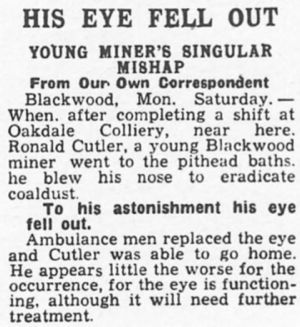
News of the World - Sep 20, 1942
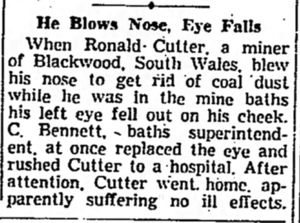
Kingston Daily Freeman - Oct 29, 1942
In April 1899, a similar case was reported in the Southern California Practitioner (which in turn got the story from a German-language paper, the Illinois Staatz Zitung). A glass blower blew his nose violently, and his right eyeball came out of its socket. A colleague was able to put it back in, but on the way to the doctor's office the same thing happened again... and then a third time at the doctor's office.
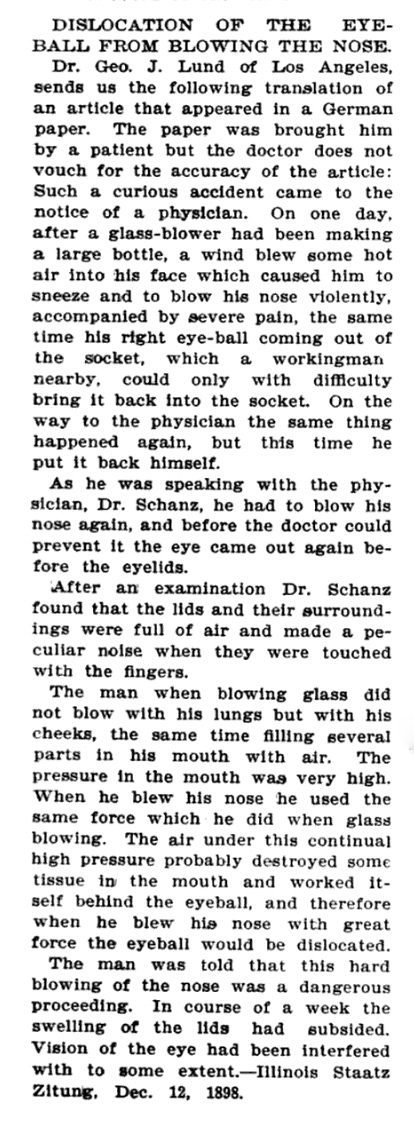
There's an old legend that if you sneeze with your eyes open, your eyeballs will come out. Mythbusters says that's not true, noting, "although a sneeze can erupt from your nose at an explosive 200 miles per hour, it can't transfer this pressure into your eye sockets to dethrone your eyeballs. Plus, there's no muscle directly behind the eye to violently contract and push the orbs outward."
How then do we explain these odd cases of eyeballs coming out when people blow their nose?
Update: I just found a third case of eyeball dislocation following nose blowing, reported by Dr. John Tyler of Kansas City in 1888. His patient, upon waking in the morning, "felt the need of a good, hard blow, and said he really was making an extra effort, when to his horror and amazement he felt his left eye pop right out between the lids, and stick!" His wife popped the eye back in, and the man suffered no apparent damage from the incident.
Posted By: Alex - Sat Dec 10, 2016 -
Comments (1)
Category: Body, Eyes and Vision, Health
Beneficial Infertility
In 1977, the head of the National Peach Council, Robert K. Phillips, sent the following letter to the U.S. Department of Labor protesting their proposed ban on the pesticide DBCP, which had been found to cause sterility among male agricultural workers who handled it. Phillips noted that some men might actually want to become sterile, so for them infertility would be a welcome benefit of the job.Recently we received the interesting DOL news release concerning worker exposure to DBCP.
It appears to us that you and Secretary Marshall may have overreacted, or at least that is your public posture.
While involuntary sterility caused by a manufactured chemical may be bad, it is not necessarily so. After all, there are many people who are now paying to have themselves sterilized to assure they will no longer be able to become parents.
How many of the workers who have become sterile were of an age that they would have been likely to have children anyway? How many were past the age when they would want to have children? These, too, are important questions.
If possible sterility is the main problem, couldn't workers who were old enough that they no longer wanted to have children accept such positions voluntarily? They could know the situation, and it wouldn't matter. Or could workers be advised of the situation, and some might volunteer for such work posts as an alternative to planned surgery for a vasectomy or tubal ligation, or as a means of getting around religious bans on birth control when they want no more children.
We do believe in safety in the work place, Dr. Bingham, but there can be good as well as bad sides to a situation.
Above all, please don't try to get a ban on the manufacture and sale of the chemical DBCP, because that would cause some losses of agricultural production which would be serious.
Sincerely,
Robert K. Phillips
Executive Secretary, National Peach Council
Despite Phillips's appeal, DBCP got banned anyway, because in addition to the sterility it was linked to various cancers. More info: NY Times, Multinational Monitor.

Posted By: Alex - Fri Nov 25, 2016 -
Comments (4)
Category: Government, Health, 1970s
The Goat Lymph Cure
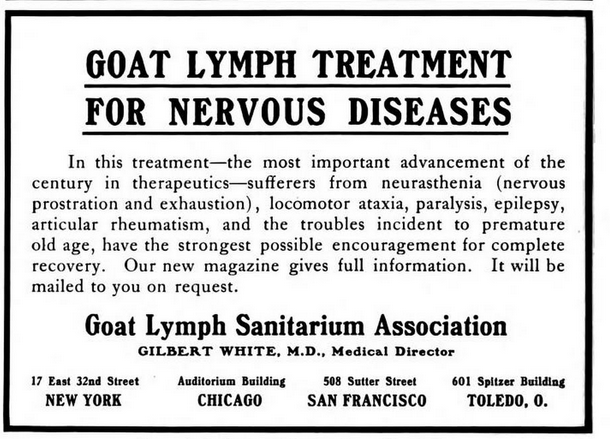
Original ad here.
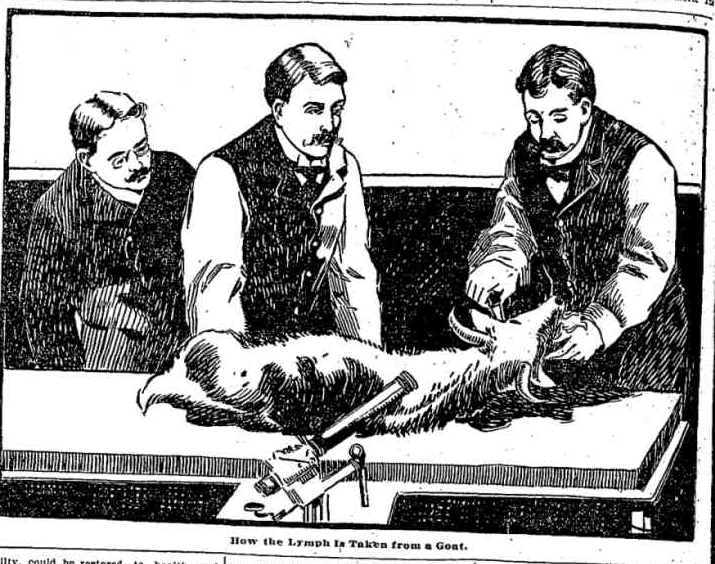
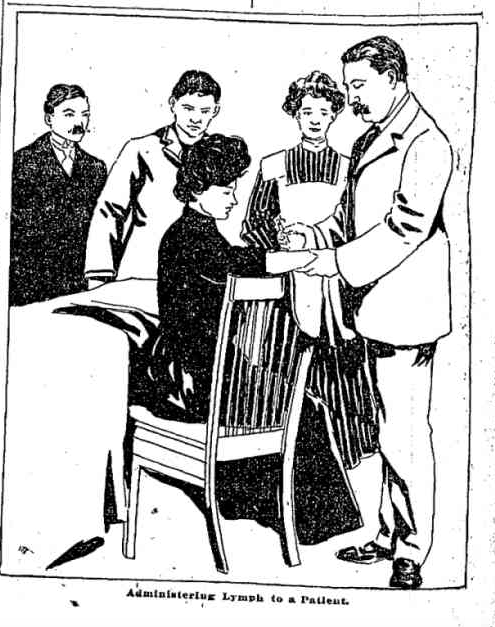
Posted By: Paul - Wed Oct 05, 2016 -
Comments (3)
Category: Animals, Health, Patent Medicines, Nostrums and Snake Oil, Body Fluids, 1900s
AbsorbPlate
It's a plate that makes food healthier by soaking up excess calories, according to its creators (the Thai Health Promotion Foundation and BBDO Bangkok):I have an idea that would work even better — a smaller plate.

Posted By: Alex - Fri May 20, 2016 -
Comments (8)
Category: Food, Health, Inventions
Allergic to Money
A few cases from the historical record of people who were allergic to money.The obligatory joke in this situation: "I'm not allergic to money, but it's allergic to me."

Medford Mail Tribune - Mar 13, 1953

Arizona Republic - Aug 19, 1954

The Wilmington News Journal - Jan 8, 1963
Posted By: Alex - Thu May 19, 2016 -
Comments (2)
Category: Health, Money

| Who We Are |
|---|
| Alex Boese Alex is the creator and curator of the Museum of Hoaxes. He's also the author of various weird, non-fiction, science-themed books such as Elephants on Acid and Psychedelic Apes. Paul Di Filippo Paul has been paid to put weird ideas into fictional form for over thirty years, in his career as a noted science fiction writer. He has recently begun blogging on many curious topics with three fellow writers at The Inferior 4+1. Contact Us |




